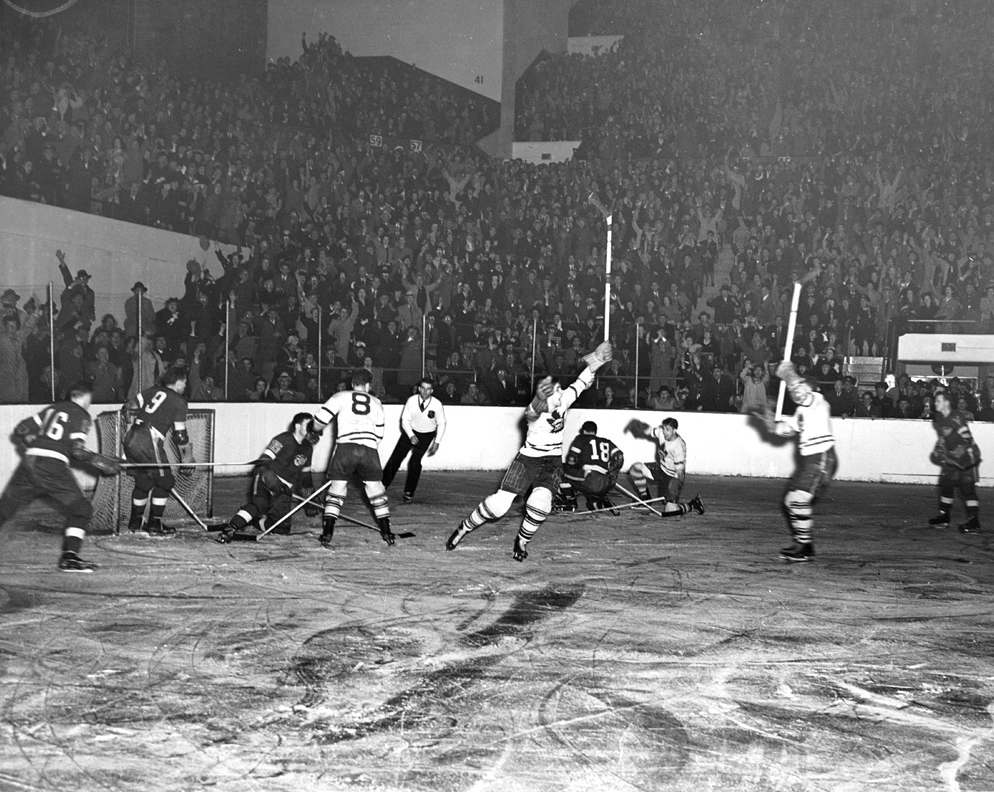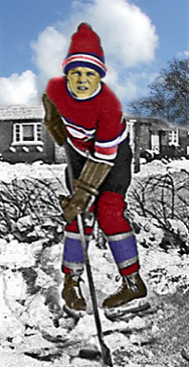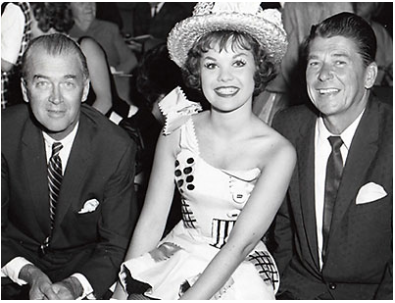Strangely, I even take pleasure watching arena ice freeze up after a Zamboni passes by, perhaps a leftover memory of watering my backyard rink for my kids on a crisp winter night.
Ice sports have been a dominant pursuit for members of my family for many decades, which was remarkable considering my siblings and I were born in Buenos Aires, where ice was apparent only in beverages. Arriving in Montreal as youngsters, my sister, brother, and I took to frozen ponds and then outdoor skating rinks with great enthusiasm. When just ten years old, my father took me to the Montreal Forum (as a guest of my Great Uncle William Northey) to see my first professional hockey game, where I witnessed some of hockey’s greats at the heights of their careers – Jacques Plante, Rocket Richard, John Belliveau, Bernie “Boom-Boom” Geoffrion, Butch Bouchard, and other notables on the Canadians team, and Terry Sawchuk, Gordie Howe, Ted Lindsay and Alex Delvecchio playing for Detroit. That thrilling experience initiated my life-long passion for the game.
Hockey legacy family
My mother’s uncle, William M. Northey (1872-1963), was a noted Canadian sportsman and founder/president of the Canadian Arena Company, which built the world’s first arena planned specifically for hockey, in Westmount, Quebec in 1897, followed by the Arena Gardens in Toronto in 1912, and then finally the historic Montreal Forum in 1924 – the home of the legendary Montreal Canadians. He served as Franchise Owner and President of both the Montreal Maroons (the English-speaking team inaugurated in 1924) and later the Montreal Canadians (formerly Les Canadians, the French-speaking team), which unified in 1938.
I can still recall being overwhelmed as I entered from a darkened hallway into the electric pregame atmosphere of the packed Montreal Forum, and then by sitting in a private box seat (near ice level) beside my dad, Uncle Northey, Senator Hartland Molson, and General Manager Frank J. Selke Senior. I was probably in the very seat occupied by Princess Elizabeth (a few months before her coronation) or Philip, the Duke of Edinburgh, when the couple had been hosted by Uncle Northey to witness their first full hockey game on October 29, 1951 (apology for the royal name dropping!). During intermission, I was brought along into the VIP lounge, where I was struck by the pleasant aroma of fresh coffee and the sight of pyramids of sandwiches with all the crusts neatly trimmed off. Back in my seat, I was astonished at the sharp crack of the puck hitting the glass right in front of me, and the brutal thuds of players being checked into the boards. During the exciting match, an errant puck landed in my lap; what a souvenir. It was truly a magical night to remember forever.
Uncle Northey was well known in hockey circles, being the driving force behind the Canadian Amateur Hockey Association, the Allan Cup, and the Hockey Hall of Fame in Toronto. He was made Honorary President of the Hockey Hall of Fame in 1944 and was inducted as a Builder in 1947. Instrumental in several major hockey innovations, he arranged for a crossbar and netting to be added onto the two-post goal, changed the two 30-minute periods to three 20-minute ones, and dropped one of the three defensemen, known as the ‘Rover.’ His name was inscribed on the Stanley Cup three times (1953, 1956, 1957) as Executive Vice-President of the Montreal Canadians. Decades later, I inherited his 1952-1953 silver cup commemorating the Canadians’ Stanley Cup victory over the Detroit Red Wings. I subsequently donated the cup to the Canadian National Archives, along with a large collection of his sports-related papers and memorabilia, including a draft and correspondence relating to his planned book on “The Origins and Development of Ice Hockey in Canada.”
Among his many voluntary memberships and accolades in sport, Uncle Northey was a member of the Commonwealth Games Committee, the Canadian Olympic Committee, and was elected to the Canadian Olympic Hall of Fame as a Builder in the hockey category. While an Honorary President of the Canadian Amateur Skating Association, he watched my sister Jean’s figure-skating career progress, as she soon won the Eastern Canadian Figure Skating Championship. Shortly afterwards, Jean turned professional as a soloist with the Ice Follies, which has toured major North American cities since 1936. At annual premier shows in Hollywood, she posed at rink side with numerous actors, including Jimmy Stewart, Ronald Reagan, Bob Hope, Loretta Young, and Ernest Borgnine, and was in constant demand for media interviews due to her exuberant personality and dedication to skating. Jean had honed her early skating skills in backyard and community center rinks at our home in St. Lambert, Quebec.
My brother John became a proficient hockey goalie, honing his early defensive moves in our basement, with a worktable serving as goal posts. I spent so many hours trying to slap shot tennis balls past him. Years later, he spearheaded the University of Toronto hockey team into winning a streak of Canadian championships and played successfully against the Czechoslovak national hockey team at the advent of modern international games. He was subsequently invited to try out with the newly recruiting Los Angeles Kings Hockey Club but declined the offer in order to complete his law degree and start a legal business.
What happened to the game?
I enjoyed playing hockey for many years as a youth in St. Lambert. My friends and I dressed in our equipment at home, skated several long blocks on snow- and ice-packed streets to our local outdoor rink, cleared the snow with heavy steel push-plows, played for three periods, and then skated home (I know this sounds like the comical; “When I was a kid...”). Frost-bitten ear tips and broken eyeglasses were simply small prices to pay for all that fun. Any idea how hard it is to find lenses once scattered on the ice? I can still recall the feeling resulting from a puck in the face. No one wore head gear back in the 1950s (none had been invented yet), so my anxious mother acquired for me a leather helmet (the kind early airplane pilots wore!), which I foolishly refused to wear for fear of ridicule. After each game I usually collapsed in front of the crackling fire. All my teammates and I were in great shape from this rigorous routine, as no one had to be driven to and from an indoor arena with a Zamboni-cleaned ice surface. Sadly, I had to abandon playing hockey during my university years at McGill and Illinois, and after moving to Winnipeg, I focused on setting up home, new employment, and starting a family.
Around this time, I happened to attend the games of several local high-school-aged teenagers and was struck with how violent the game had become. Edged on by rowdy spectators, some of whom delighted in, and cheered for, every bone-jarring body check, it now seemed like my favourite game, based formerly on speed, deft stickhandling, pinpoint passing, sportsmanship, and fun, had substituted the nasty element of trying to injure opponents, or at least threaten them off their game by questionable tactics of intimidation.
It has always seemed to me that crushing someone into the boards when their back was turned, cross-checking from behind to defend the front of the net, or purposefully slamming into an opponent when their head was down, were intuitively cowardly acts. Colliding into other speeding players or sliding uncontrollably into the boards or a goal post, are entirely unavoidable in a game as fast as hockey, as I was only too aware while playing. But to purposefully attack an opponent with the intent of causing injury I feel should have no place in amateur or professional hockey. One can take an opponent out of a play with a legitimate body check without administering serious harm. I had hoped the age of hockey ‘goons’ and ‘enforcers’ was over in the modern state of the sport, but such is not the case; teams must still actively defend their most-skilled player assets by any means possible. The resulting fights occur in almost every professional game.
I know there are established penalties in the rule book for charging, boarding, cross-checking, head contact, kneeing, fighting, and roughing with intent to injure, but referees must have been instructed long ago by league owners and managers to let many of these infractions go, with the purpose of making matches more exciting for audiences. “Let the players play,” “Let them settle their disputes on the ice,” and “Don’t slow down the game with too many penalties,” are often stated as rationales for permitting cheating play. The miss or ignoring of a penalty, or inconsistent calls, by referees (whose job is clearly challenging) exacerbates the frustration level of players and encourages retaliation. In the Winnipeg Arena, I remember vividly “The Golden Jet,” Bobby Hull, weaving his way through an opposing team and hearing the thuds of lumber applied to his legs and arms, all without a penalty being called.
Frenzy for violence
Fan frenzy for violence and fighting during a game sadly appeals to our species’ enthusiasm for witnessing aggression, not much different than occurred over two millennia ago during vulgar gladiatorial events featured in Roman amphitheaters. I would like to see the “Intent to Injure” component of the rule book enforced with more significant consequences than a major penalty or a few-games suspension (especially for causing severe injuries), a change that would greatly clean up ugly aspects of the sport. How many missed games due to knee injuries, repeated concussions (often leading to permanent brain trauma), broken bones, prematurely ended careers, and even occasional tragic deaths have to occur at any level of hockey before rational regulations are put in place to protect players. Accidents happen but acts of purposely attacking an opponent should not be tolerated. Trained referees can tell the difference.
To recapture my youth and love of hockey, I decided to join an old-timer (i.e., over 50 years of age) league, where although remaining quite competitive, body checking and slap shots were not allowed, for obvious player safety. And although I greatly enjoyed participating, and the camaraderie of my team mates, and didn’t mind too much games scheduled for 11:00 pm on work nights and Sunday mornings at 8:00 am (the only times ice was available), even here, occasional bad on-ice behaviour forced me into a final decision to retire from the sport (personal minor injuries, but an opposing goalie died from complications arising from a broken leg). Fortunately, I am still able to enjoy skating a couple of times a week in local arenas, attending an occasional Winnipeg Jets game through the generosity of a close friend, and games broadcast on television. Strangely, I even take pleasure watching arena ice freeze up after a Zamboni passes by, perhaps a leftover memory of watering my backyard rink for my kids on a crisp winter night. The old ice instinct is still there after more than 70 years. For my family and many others, a passion for ice sports seems to be at the very core of being Canadian.




